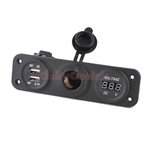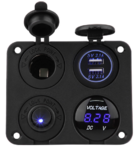sydnsue
Full Member
- Messages
- 260
I have a DJI drone that uses quite meaty batteries and I charge them via the 12V socket in the living area in my van. (Not the dash sockets). When I connect the 12V charger, the lights on the battery illuminate to show it is charging but they light for a few seconds, then go off for a few seconds, then light for a few seconds etc, etc. I assumed this meant that the socket was unable to supply the required current and the charger was switching in and out. However, if I plug an inverter into the same 12V socket and then run the 240V charger from the inverter, the lights on the battery remain on. Surely the load is the same for both chargers. In fact I would have thought the inverter would have been worse due to the inefficiency of the inverter.
So what is happening? The numbers on the chargers are as follows:
Mains charger - INPUT 240V 1.8A. OUTPUT 17.6V 3.41A
12V charger - INPUT 14V 6.5A OUTPUT 17.6V 4.54A
On the face of it, it seems obvious that the 12V charger is a higher current, hence the overload problem, but surely it is the battery that draws the current. The figures on the chargers are only what they are capable of. I thought the battery would draw the same current whichever charger was used. In which case why is the 240V charger through the inverter not flashing on and off.
The bottom line is - how do I use the 12V charger?
So what is happening? The numbers on the chargers are as follows:
Mains charger - INPUT 240V 1.8A. OUTPUT 17.6V 3.41A
12V charger - INPUT 14V 6.5A OUTPUT 17.6V 4.54A
On the face of it, it seems obvious that the 12V charger is a higher current, hence the overload problem, but surely it is the battery that draws the current. The figures on the chargers are only what they are capable of. I thought the battery would draw the same current whichever charger was used. In which case why is the 240V charger through the inverter not flashing on and off.
The bottom line is - how do I use the 12V charger?


